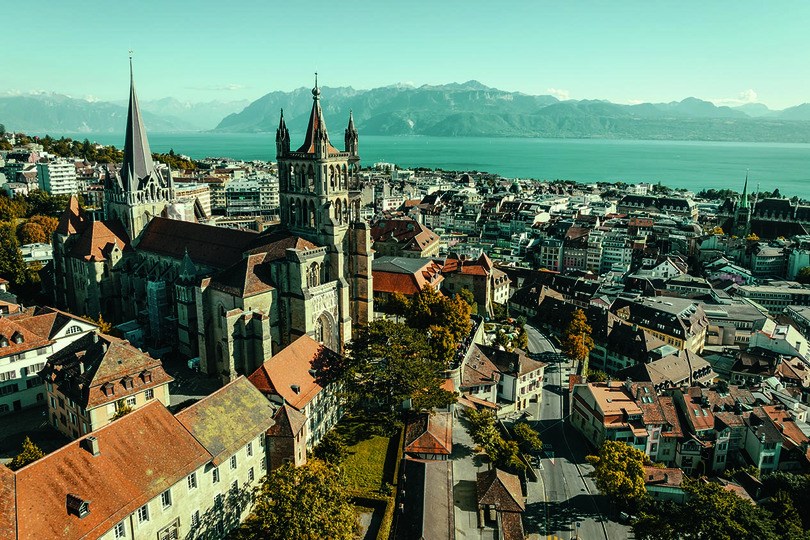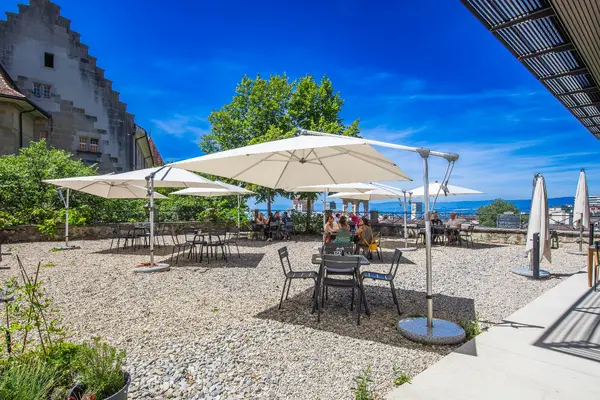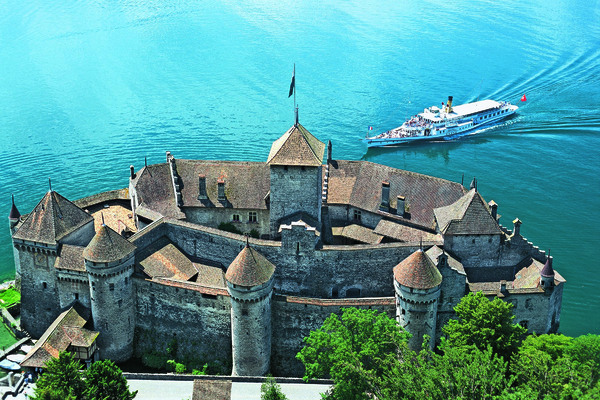03 Oct 2024by Ellie Ross
Ellie Ross
Other

Lausanne’s Gothic cathedral is in the heart of the old town (Credit: Switzerland Tourism / Lorenz Richard)
“Every time it rains a little bit of our cathedral disappears,” says Annie Hagmann, a Lausanne local and tour guide for the region. The imposing cathedral sits high about the city, built from locally mined rock. It’s constantly being touched up, as the pale yellow sandstone disintegrates over time. Luckily, the Vaud canton is known for its slightly warmer climate than Switzerland’s best-known Alpine regions, which means less rain and less erosion. It’s a cathedral that dominates a land of sloping green fields that feels more like Tuscany or Bordeaux than the craggy Bernese Alps just a short train ride away.
Across Lac Leman (Lake Geneva), the French Alps glint in the afternoon sunlight. So far, so Swiss. And yet I’m also in the middle of wine country. The Vaud produces the second highest amount of Switzerland’s wine, 90% of which is consumed by the Swiss. Looking around from the hill in the centre of Lausanne, the steep, mineral-rich slopes of Lavaux are perfect for vines. There’s even a tiny vineyard squeezed just behind the La Buvette Vaudoise (labuvette-vaudoise.ch) based inside the Canton of Vaud’s parliament building where we eat lunch – “one vine for every 152 MPs” says Annie.
In contrast to the rest of Switzerland, which I’ve visited on ski trips and mountaineering adventures, the centre of Lausanne feels like more of a relaxed market town, packed with locals and good food. Markets fill the streets with locals stopping to chat with producers as fistfuls of carrots are exchanged for Swiss Francs. There are no thronging tour groups taking selfies in front of the Matterhorn. Instead, it feels like Switzerland for the Swiss. Lausanne’s old centre is a charming warren of medieval backstreets and ancient wooden buildings that threaten to topple down the hill and into the lake below – all with that Swiss sheen, of course.
It’s also clear from a sign counting down 234 days until the youth basketball world cup outside the train station that Lausanne is sports mad. This is a city where the International Olympic Committee is headquartered, and there are 50 or so other global sports federations that call Lausanne home. There are runners everywhere, while lycra-clad cyclists power their way up Lausanne’s ultra-steep hills that make it such a good wine-growing region. Other than a quaint run of wooden steps that run directly up to the cathedral, visitors luckily don’t need to spend their days climbing. I was relieved to see a punchy metro system that covers the hills for me, all accessible with a Lausanne travel card.
I zip up the hill to the four-star Hotel de la Paix, which has the sort of view that makes it hard to leave. The best rooms have spacious balconies with enough room to take an early-morning coffee, but that would be a waste of caffeine because this is a city that takes refuelling seriously: there are well-positioned cafes like Le Barbare (lebarbare.ch) on every corner that invite you to recover and sink into soft chairs to sip the silkiest hot chocolate this side of the Alps. Haggman says: “I remember drinking hot chocolate at Le Barbare as a child, and today it’s where my daughter goes to hang out after school too. It’s an institution.”
With its farming roots, it makes sense that Lausanne is packed with shops stuffed with cheese and specialities from across the Vaud region. Being Switzerland, of course, that also means chocolate. There are 11 chocolate shops, from Jorge Cardozo, which specialises in chocolate sculptures, to Durig, which is the home of organic chocolate.
My walking tour guide introduces me to a sausage stuffed with cabbage (saucisse aux choux vaudoise), a reminder that for all of Switzerland’s banking connotations, this canton was, until the mid-20th century, a poor farming area. A propensity to farming combined with steep slopes and a temperate climate results in a thriving viticulture scene. The canton of Vaud is the second largest wine region in Switzerland, and its proximity to the lake in addition to the creative and historic centres of Lausanne and Geneva, means that wine can accompany, rather than dominate the trip.
To learn more about Swiss wine, I make a beeline for tiny natural wine store Mosto Vins (mostolausanne.com), which has a tasting cellar tucked underneath the shop. I try a punchy orange wine packed with rich apricot flavour and minerally whites. Sommelier Valentin explains that natural wines are really booming in Switzerland. “There are just two natural wine shops in Lausanne, but when people want to find out more it’s customary to go straight to the vineyard to buy.”
That’s exactly what I decide to do. The next morning I hop on a train that loops around Lake Geneva, along the Montreux Riviera. I’m heading to Vevey, a genteel holiday town which is the perfect jumping-off point to explore the Lavaux region. Travelling around the Vaud region can be done with your eyes closed, thanks to Swiss Tourism’s commitment to sustainable travel, Swisstainable. There’s always a public transport connection, even to remote-sounding wine terraces and mountain peaks. It’s a refreshing change not to worry about booking taxis.
Vevey is a riviera town right on the edge of the lake, and even towards the end of September despite there being a definite chill in the air, some of the after-work crowd are dipping their toes in and heading for an evening swim. Others lounge around, making the most of an intense orange sunset. Framed by the French Alps glowing pink on the other side of the lake, it’s a pastel evening and I take a long walk past swimming coves and lake-front bars serving their last drinks before autumn takes over.
To prepare myself for a day of wine tasting at the vineyards, I line my stomach at Ze Fork (zefork.ch), a lakeside restaurant with a seasonal, ever-changing menu. It’s a romantic spot in an ancient lakeside house, and the white walls glow orange as the sun sets behind the mountains.
Predominantly a steakhouse, I’m more excited by the list of appetisers which includes Malakoffs, a deep-fried ball of strong Swiss cheese that multiple people have recommended. The waiter tells me that these are: “winter fuel”. The name originates from the Battle of Malakoff when Swiss mercenaries apparently invented these tiny balls of punchy fried cheese (Gruyere, Appenzeller and Emmental). After a few bites I can see how they would keep an army going for months.
The next day feels autumnal, and Lac Leman glints silver in the cold morning air. I board the train from Vevey to the Lavaux wine region, and fifteen minutes later I’m standing at the base of the hill that leads up to the vineyards, staring down at slopes that could be in Tuscany. It’s a glittering panorama and at the Domaine Dizerens winery (dizerensvins.ch) we taste a robust Moulin-la Vignette Pinot, which pairs well with the autumnal chill.
The Vaud region offers more for your clients than just excellent produce. To build up an appetite the lake is one of the cleanest in Europe for swimming, Castle Schillon (chillon.ch) – a boat ride down the lake’s edge – is an historical and well-preserved marvel, and out-of-this-world forest hikes are accessible by funicular railway from the hills above Vevey and Montreux.
Vaud is a region where all of Switzerland’s highlights come together in an easily accessible package, making it ideal for a long weekend break from Geneva or an add-on to a mountain trip. “After decades of living around the world in the UK, France and Japan, I came back to Lausanne and suddenly realised it had absolutely everything I ever wanted,” says Annie Haggman. “It’s perfect.”
Book it: Switzerland Travel Centre offer three nights in Montreux, based on two adults sharing, from £563pp, departing 31 May, 2025. Price includes hotel (bed and breakfast), trains, visit to the Château de Chillon and wine tasting in Lavaux; switzerlandtravelcentre.com
Inghams offers seven nights at the Hotel Rene Capt in Montreux, based on two adults sharing, from £1,269pp, departing Luton airport on 31 May 2025. Price includes flights and half-board accommodation; inghams.co.uk


